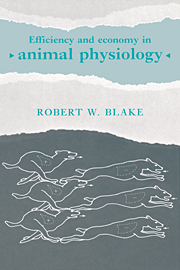Book contents
- Frontmatter
- Contents
- List of contributors
- Preface
- 1 Efficiency, effectiveness, perfection, optimization: their use in understanding vertebrate evolution
- 2 On the efficiency of energy transformations in cells and animals
- 3 Adapting skeletal muscle to be efficient
- 4 Efficiency and other criteria for evaluating the quality of structural biomaterials
- 5 Efficiency and optimization in the design of skeletal support systems
- 6 Efficiency in aquatic locomotion: limitations from single cells to animals
- 7 The concepts of efficiency and economy in land locomotion
- 8 Respiration in air breathing vertebrates: optimization and efficiency in design and function
- 9 Cardiac energetics and the design of vertebrate arterial systems
- 10 An evolutionary perspective on the concept of efficiency: how does function evolve?
- Index
3 - Adapting skeletal muscle to be efficient
Published online by Cambridge University Press: 03 October 2009
- Frontmatter
- Contents
- List of contributors
- Preface
- 1 Efficiency, effectiveness, perfection, optimization: their use in understanding vertebrate evolution
- 2 On the efficiency of energy transformations in cells and animals
- 3 Adapting skeletal muscle to be efficient
- 4 Efficiency and other criteria for evaluating the quality of structural biomaterials
- 5 Efficiency and optimization in the design of skeletal support systems
- 6 Efficiency in aquatic locomotion: limitations from single cells to animals
- 7 The concepts of efficiency and economy in land locomotion
- 8 Respiration in air breathing vertebrates: optimization and efficiency in design and function
- 9 Cardiac energetics and the design of vertebrate arterial systems
- 10 An evolutionary perspective on the concept of efficiency: how does function evolve?
- Index
Summary
INTRODUCTION
The efficiency with which a muscle converts chemical free energy into mechanical work is adaptively important in prolonged aerobic locomotion, for example in migration. Cruising locomotion is characterized by cyclic contraction at a well defined frequency, in which each muscle actively shortens, and is then passively stretched back to its original length. The muscle does a certain amount of work (the ‘cycle work’) in each cycle (Fig. 3.1). The average rate of doing work, that is the mechanical power output, is found by multiplying the cycle work by the contraction frequency.
Since the limbs of vertebrates and arthropods are actuated by muscles directly, without the intervention of any form of reduction drive, the frequency of contraction is necessarily the same as the stepping frequency for a terrestrial animal, or the frequency at which a flying animal beats its wings, or a swimming one beats its tail or flippers. The frequency at which any particular animal oscillates its limbs is determined by mechanical considerations, the general nature of which was discussed by Hill (1950). ‘Natural’ frequencies of limb oscillation in terrestrial locomotion have been considered by Alexander (1976, 1980), and for flying animals by Pennycuick (1975a, 1990). For present purposes, it is sufficient to note first, that the range of frequencies available to a particular animal in cruising locomotion is narrow, and second, that there is a strong trend for larger animals to oscillate their limbs at lower frequencies than smaller ones of similar general type. This latter trend is plainly visible to the naked eye.
- Type
- Chapter
- Information
- Efficiency and Economy in Animal Physiology , pp. 33 - 42Publisher: Cambridge University PressPrint publication year: 1992
- 1
- Cited by



